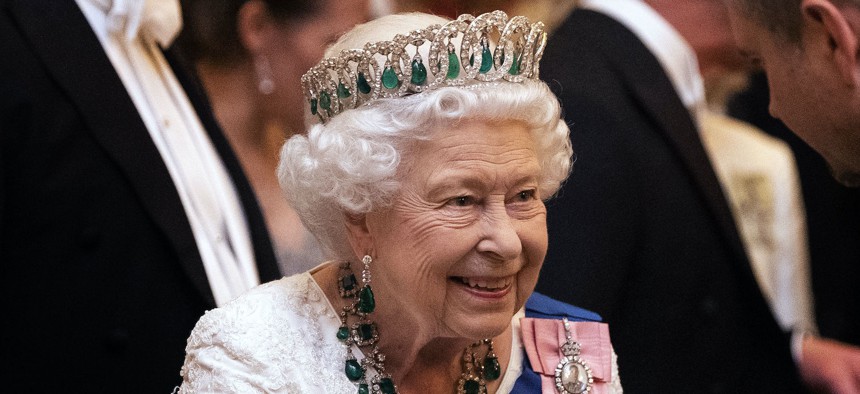
Queen Elizabeth II talks to guests at an evening reception for members of the Diplomatic Corps at Buckingham Palace on December 11, 2019, in London, England. WPA Pool via Getty Images / Victoria Jones
Queen Elizabeth II Dead at 96
King Charles III succeeds Britain’s longest-serving monarch and most prominent global leader.
This story was updated at 2:17 p.m.
Queen Elizabeth II died Thursday in Scotland, ending her 70-year reign as one of the world’s most visible diplomats.
She is succeeded as monarch by her son, now King Charles III, a Royal Navy veteran who is expected to maintain the queen’s bullish position on the need to combat climate change. Last year, Charles urged the world to adopt a “warlike footing” and launch a “military-style” effort to fight rising global temperatures.
“The Queen died peacefully at Balmoral this afternoon,” the Royal Family announced on Twitter. “The King and The Queen Consort will remain at Balmoral this evening and will return to London tomorrow.”
Elizabeth’s death at 96 comes just days after she met with Liz Truss, the 16th prime minister to serve during the queen’s tenure.
“She was the very spirit of Great Britain and that spirit will endure,” Truss said Thursday. “Today the crown passes as it has done for more than 1,000 years.”
“God save the king,” said the prime minister.
As monarch, the queen does not have the political power held by senior elected officials, such as the prime minister or members of Parliament. She never weighed in publicly on Brexit, the UK’s most fraught foreign-policy move of the past decade.
But she played a major role in global relations as arguably the United Kingdom’s most prominent stateswoman, and has spent her 70 years as monarch traveling more than 1 million miles to visit countries where she is head of state as well as other allies. She has visited 117 of the 195 countries, according to The Telegraph.
She met 13 American presidents, starting with Harry Truman on her first visit to Washington in 1951 as princess, just three months before the death of her father. In 1957, Dwight Eisenhower hosted her first state visit as queen. Last year, she met with Joe Biden in London.
Leaders rushed to offer their condolences on Thursday, and praised the queen for her leadership during numerous historic events beginning with the aftermath of World War II.
“In her 70 years on the throne, she bore witness to the most consequential events that our world has ever seen and helped foster the close and important relationship that the United States shares with the United Kingdom,” Sen. Jeanne Shaheen, D-N.H., said in a statement.
Her role as a senior stateswoman has earned her praise from many in the diplomatic corps.
“Her majesty is very well-informed; she is aware of what's happening in the world. So that is why most of the diplomats, not only me, love her. She is a lovable person. And she understands everything,” Khaled Al Duwaisan, the Kuwait ambassador to the United Kingdom, said in June.
In 1986, she became the first British monarch to visit China, a crucial visit to strengthen ties between the two nations after the United Kingdom agreed that Hong Kong would be returned to China in 1997 after the expiration of a 99-year lease. In February, Chinese President Xi Jinping congratulated the queen for her 70-year rule and called for a closer relationship between Beijing and London.
Her diplomatic victories continued into her old age. In 2011, Queen Elizabeth became the first British monarch to visit Ireland nearly a century after Dublin declared independence from the United Kingdom. The Irish president returned the visit in 2014.
"She's been astonishingly effective as a diplomat and as a statesperson. It's a great argument against possibly retirement because she's certainly managing her advanced years astonishingly well,” Ninian Mellamphy, a professor emeritus at Western University in Canada, said after the visit.
The queen joined the British Army when she turned 18 during World War II, earning the nickname “Princess Auto Mechanic” for her service as a vehicle mechanic. She was the last living head of state to serve during World War II, according to the National World War II Museum.




